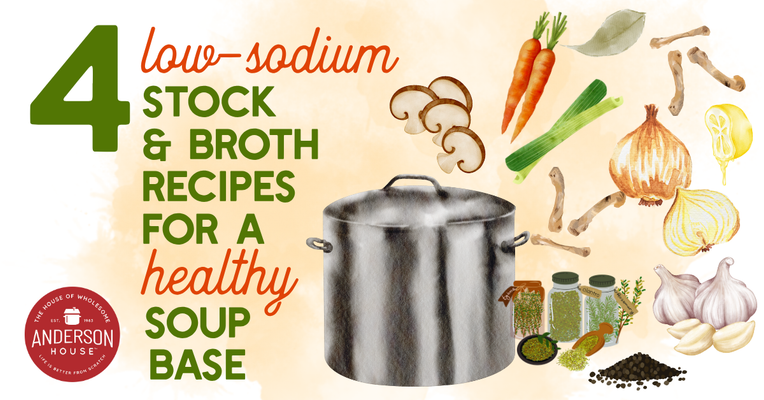4 Low-Sodium Stock and Broth Recipes for a Healthy Soup Base
Posted by Eunice Juanzo on Jun 1st 2023
A rich, flavorful base can elevate any soup from ordinary to extraordinary. When making soup at home, most of us rely on boxed broth, a bouillon cube, or—when there’s time—a big pot of homemade goodness simmering away on the stove.
I asked my colleagues what they usually use, and most admitted they lean on the convenience of store-bought options. I do too! But every once in a while, I take the time to make my own—especially when I want to control the ingredients and keep things low in sodium.
We’ve also heard from some of our customers who are mindful of sodium levels and curious about how to make their soups healthier. The good news? Our mixes are already very low in sodium, and we never add salt or preservatives. To keep your soup as heart-healthy as possible, we recommend starting with a low-sodium broth or stock—and if you're up for it, making your own is easier than you might think!
Why Make Your Own Stock or Broth?
Making your own soup base is about more than just great flavor. Here’s why it’s worth the extra effort:
-
You control the ingredients: Add what you like, skip what you don’t. That means no hidden sodium, preservatives, or mystery flavor enhancers.
-
It reduces waste: Use up vegetable scraps, leftover bones, or aromatics that might otherwise go uneaten.
-
It’s healthier: Homemade stock is naturally low in sodium and free from artificial additives.
-
It tastes better: The depth of flavor you get from slow-simmered ingredients is hard to beat.
1. Easy Chicken Stock in a Pressure Cooker
Recipe from Trisha Anderson, Frontier Soups Founder
This homemade chicken stock is perfect when you want to make the most of a leftover roasted chicken. It’s rich, nourishing, and the pressure cooker helps you get deep flavor in less time.
Ingredients:
-
1 whole roasted chicken (meat removed, bones reserved)
-
1 whole onion, quartered (no need to peel)
-
2 celery ribs
-
1 medium carrot
-
5 peppercorns
-
1 Tbsp apple cider vinegar or lemon juice
-
Optional herbs (thyme, parsley, bay leaf)
Instructions:
-
Quarter the onion and clean the celery and carrot. No need to peel the vegetables—just be sure they’re well washed.
-
Place all the ingredients in the bowl of your pressure cooker. Add enough water to fully cover the bones (about 12 cups works well). If using apple cider vinegar or lemon juice, add it now to help pull extra nutrients from the bones.
-
Keep the seasonings simple with a few peppercorns, or add herbs like thyme, bay leaves, or parsley to suit your preferences. Trisha prefers a basic base stock and adds flavor later, depending on the soup she’s making.
-
Set your pressure cooker to cook for 1 hour at high pressure.
-
Once the cooking time is complete, you can either let the pressure release naturally or perform a quick release.
-
Carefully pour the hot broth through a sieve into a large bowl. Let it cool slightly, then cover and refrigerate for at least 3 hours—or preferably overnight. Discard the used bones and vegetables.
-
Once chilled, skim the solidified fat from the surface of the broth using a spoon. Remove as much or as little fat as you like, based on your preference.
-
And that’s it! You now have a rich, homemade chicken stock ready to use. Store it in airtight containers in the refrigerator if you'll use it soon, or freeze for longer-term storage.

2. Roasted Chicken Bone Stock (Stovetop Method)
From my colleague, Sue Rozema
This version also uses bones from a roasted chicken, but adds a step of roasting the bones and vegetables for extra depth of flavor.
Ingredients:
-
Leftover chicken bones (meat removed)
-
Leftover vegetables of your choosing
-
1 onion, chopped
Instructions:
-
Roast the bones and veggies at 350°F for 1 hour.
-
Transfer to a pot and add chopped onion. Cover with water.
-
Simmer covered for 1 hour.
-
Strain through a fine mesh sieve. Discard solids.
-
Cool and skim fat. Use right away or freeze for later.

3. Low-Sodium Vegetable Broth (Vegan + Budget-Friendly)
This is the only true broth on the list—made without bones, just full of veggie goodness. It’s light, flavorful, and a great way to use up scraps in your fridge.
Ingredients:
-
4 quarts (16 cups) water
-
2 carrots, peeled and diced
-
2 celery ribs, chopped
-
1–2 onions, halved
-
2–3 garlic cloves, smashed
-
Optional: a handful of mushrooms (like shiitake)
-
1 tsp dried herbs (thyme, rosemary, parsley)
-
1 dried bay leaf
-
5 peppercorns
-
1 tsp salt (optional)
Instructions:
-
Add everything to a large pot. Add water until ingredients are submerged.
-
Bring to a boil uncovered, then reduce heat and gently boil for 1 hour.
-
Strain and discard solids. Store in jars or freeze for later.

Rich Beef Bone Stock from Scratch
Inspired by Filipino cooking traditions
This one is a personal favorite! I make beef stock often when cooking traditional Filipino dishes. It’s deeply savory and satisfying. The key? Beef bones like shank or neck, and a long simmer.
Ingredients:
-
4 quarts water
-
1½ lbs beef shank or beef neck bones
-
2 onions, quartered
-
10 black peppercorns
-
1–2 dried bay leaves
-
1 tsp salt (optional)
Instructions:
-
Rinse bones. Place in a pot with cold water and bring to boil for 20 mins. Discard water.
-
Return bones to pot. Add fresh cold water and remaining ingredients.
-
Bring to a gentle boil, then lower heat to a simmer.
-
Skim the film off the top as it simmers.
-
Simmer 2–4 hours. Strain and store.

Final Thoughts: Start With a Better Soup Base
Whether you go the chicken, beef, or veggie route, making your own stock or broth is a simple way to level up your soup—and your health. You'll be amazed at how much better it tastes, even without the added salt.
So if you’ve got a quiet afternoon or a few veggie scraps to spare, give one of these recipes a try. Your next bowl of soup will thank you.
Happy cooking!


